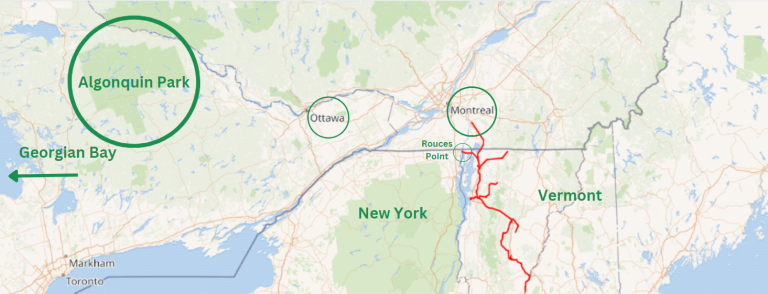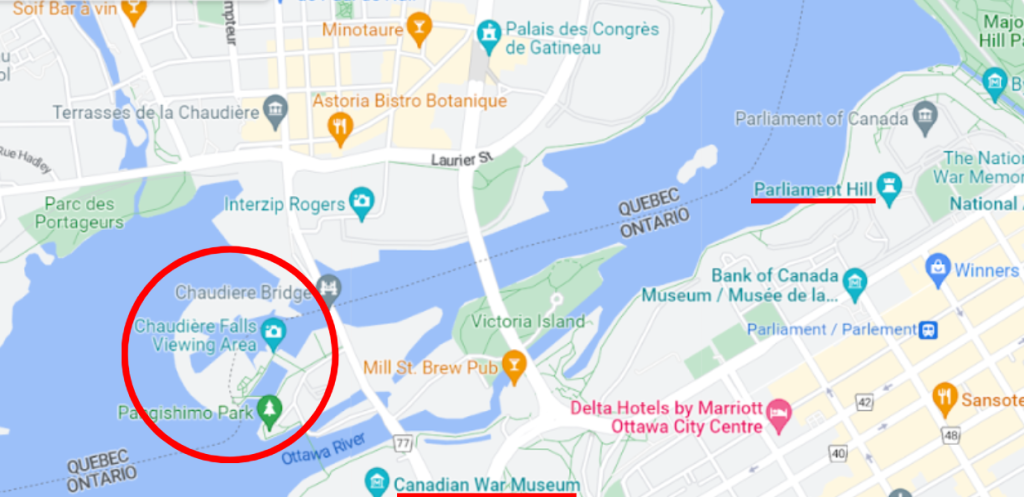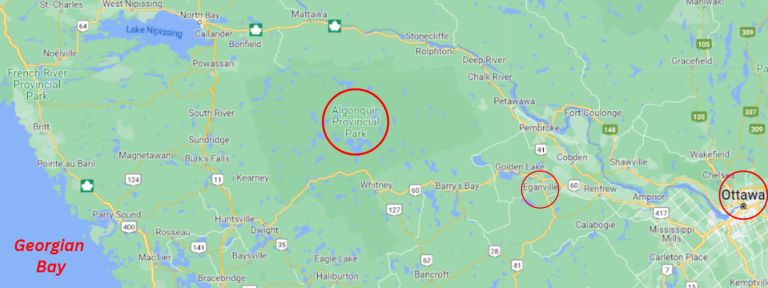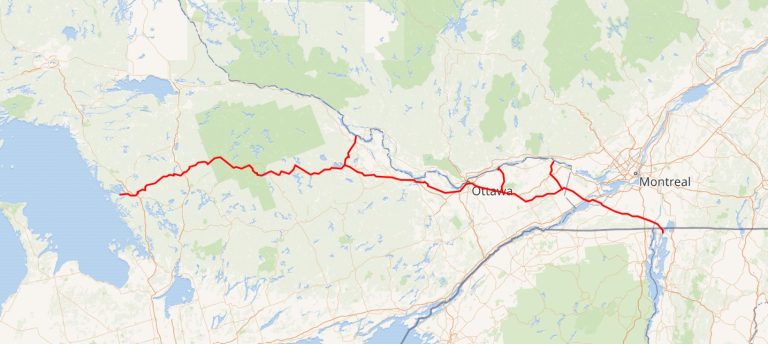Canadian History With New Eyes: The Dark Ages?
The Dark Ages & the French Wars of Religion Some time ago, I started to
Home / John Rudolphus Booth – Lumber Baron Extraordinaire
John Rudophus Booth (JR Booth) (1827-1925), was born during the time when Thomas McKay was building the Rideau Canal. He was the second of 5 children born to John and Eleanor Rowley Booth. His parents were Irish immigrants from Ulster, who farmed in Waterloo Quebec, about 80 miles East of Montreal.
JR Booth had an elementary education. His childhood pastime was building tiny mills and bridges along the little rivulet that flowed through his father’s farm.

At age 21 he considered joining the California Gold Rush. Instead, he found employment with the Central Vermont Railway – an experience which probably played a huge part in his entrepreneurial ventures in the years to come.
Vermont is the US State immediately under the Province of Quebec.
When he was 24 years old he married Rosalinda Cooke and two years later moved to the Ottawa Valley near Gatineau / Hull. Two years later, at age 28, JR and his wife moved across the Ottawa River to settle in Ottawa. There, his understanding of the lumber trade and the use of water power added to his life experiences.
While in Gatineau / Hull, he gained knowledge and experience of how mills functioned when he worked on the construction of a paper mill in Sherbrooke Quebec, followed by building a steam powered sawmill in Hull for Andrew Leamy, who hired him to manage it for a year.
In 1859, at the age of 31, he rented a mill at Chaudiere Falls to produce wooden shingles. In less than a year, the mill was destroyed by fire.
JR Booth experienced many more fires at his lumber operations over the years.

The name JR Booth became renowned. JR Booth proved to be a shrewd businessman, achieving his success by first leasing a sawmill from Philip Thompson on Chaudiere Island which lay between Hull and Ottawa. Between the ages of 24 and 31, (from 1854 -1859) he established his own company, built a sawmill and used his profits to purchase a large sawmill at the Chaudiere Falls.
In a few short years, JR Booth had become so successful in the lumber industry that in 1859, he successfully won the bid to supply the lumber to build the Parliament Buildings. Just the year before, Ottawa was chosen by Queen Victoria as the capital of Canada.
The Parliament Buildings include The East Block – completed in 1865; the West Block and Centre Block – completed in 1866; and the Library of Parliament – completed in 1876. If you have ever been inside the East or West Block you would have seen their massive, heavy, wooden doors, door frames and the exquisite woodwork in each room. All of the wood was supplied by JR Booth’s lumber. His ‘piece de resistance’ was the Library of Parliament.
His shrewdness was evident in the manner in which he won the bid. He underbid the more established lumber companies by hiring cheap labour – unemployed longshoremen, from Montreal.
He was also innovative in his lumber business, replacing oxen with horses to skid logs to the water to improve efficiency for the Parliament Hill project. He also acquired acreage for pasturing his horses at what is now known as ‘The Experimental Farm’.

To supply that much lumber, he had to have logging rights called ‘timber limits’. By 1860 he controlled logging rights for large tracts of land in Central Ontario.
He harvested lumber as far north as Georgian Bay on Lake Huron, floating the logs down the Ottawa River and its tributaries to his mills in Ottawa at the Chaudiere Falls.
He was so successful with this contract that before the East and West Blocks of the Parliament Buildings were completed, he was able to purchase more mills and their adjoining mill-lots. His reputation for quality performance gave him more access to investment financing. By 1865 Booth was the region’s third largest lumber producer, having the largest daily output of lumber in the world by 1890 (in 25 years of business).
In 1867 (the year of Confederation), on the advice of his cousin from Pembroke – Robert R Booth, and financed by the British Bank of North America, he bought 250 square miles of valuable pine forests on the Madawaska River from John Egan for $40,000. This is now part of Algonquin Park. When he was offered $1 million for rights to this parcel of land in 1872 (5 years later), he refused. He later attributed this acquisition as the backbone of his success.
By 1868, he founded the Upper Ottawa Improvement Committee to build dams, slides and piers to facilitate timber drives. He continuously expanded his milling and timber-drive business. Also in 1868, he built a dock, a lumber storage and a distribution centre at Rouses Point in New York, a border town on the Richelieu River, south of Montreal. Seven years later, in 1875, he had also expanded to build a planing mill and box factory in Burlington, Vermont. Two years later, he had established a sales office in Boston becoming the first Canadian lumber baron who manufactured his own American lumber in his own American factory.
In his 40’s, between 1874-1876 during an economic downturn in the lumber industry, he demonstrated more shrewdness by purchasing the timber limits (license) at low prices from other limit-holders. This made him completely self-sufficient because he eliminated his dependence on suppliers. He eventually amassed 640,000 acres of timber limits which stretched all across the Ottawa Valley and encompassed the watershed of the Ottawa River both in Ontario and Quebec.
In 1881, by the time he was 54 years old, he had expanded his timber limits to the watershed of Lake Nippising. To solve the problem of portaging his logs from Lake Nippising to the Mattawa River, he built a 5 ½ mile railroad, to get his sawlogs to his mills at the Chaudiere more efficiently. By the end of the 1800s, he owned almost 7000 square miles of timber rights in Central and Northern Ontario. Another lumberman – George Arthur Grier claimed that Booth ‘knew the forest like a sailor knows the sea’, because he traveled non-stop throughout his timber holdings.
Ten years later (1891) he had the most band saws in the world (3), dominating the market in his production of sawed lumber and in setting the market price for lumber. It is said that he needed 2 million logs to keep his mills running at capacity and it took 2 years for his lumber to get from his timber limits to the mill.
By the time he was 65 years old in 1892, he had the largest lumber complex in the world – 140 million board feet of lumber, shipping half his products to Britain and the rest to other parts of Canada and the United States. White pine from his lumberyard was used by Cunard Lines (makers of the Titanic) to build ships like the Lusitania and Mauritania.
In 1893, and 1895, fire ravaged his mills. In 1895, his Burlington Vermont mill was gutted. Because of that he needed 20 British, 5 American and 3 Canadian insurance companies to underwrite his insurance.

By 1897, this 70-year-old again diversified his portfolio of businesses one more time by adding the export of Prairie grain to it. He owned the Canada Atlantic Railway which he harnessed to both extract and export his logs, and to also export grain from the Prairies, to American and European markets. The railway stretched southward from Georgian Bay on Lake Huron in the North, to Lake Champlain in Vermont.
It is said that by 1897, he often visited his Algonquin timber limits in his own private railway car. He led by example, working side by side with his workers by day, and doing his administrative affairs by night. He found solutions for just about every obstacle he met in the industry especially if it would reduce his costs. For example he invested in tugboats in 1894, to expedite the delivery of log booms to his mill at the Chaudiere.
In 1900, fire cut through Ottawa and Hull. He lost 100 million feet of lumber, between $1 and 1 ½ million, and his home at the corner of Wellington and Preston. He also lost much of his personal and business records in the fire. Again in 1903, his mills were ravaged by fire. He lost 10 million feet of lumber and 8 railway cars. Many buildings and homes in the vicinity were also lost.
Most men would retire long before their 78th birthday… not so John Booth. Always innovating, always diversifying, he built a pulp and paper plant in 1905 to utilize the softwood he previously sold. Because of the large output of the mill, the Fraserfield lumberyard and railyard he purchased in 1870, extended all the way down Bronson Avenue to Carling and backed onto the Glebe.
By 1909, at 82 years old, Booth built a Hydroelectric plant at the Chaudiere Falls to power his sawmill and planing mill. That raised the level of the Ottawa River by 10 feet, effectively bringing to an end the practice of floating log rafts down the river. Because he was not able to ship his lumber out of the lumberyards fast enough, his mills ran under capacity. At the age of 87 years old, in 1913, fire visited his business once again.
By 1917, citizens and the City Council expressed concern about the risk of fire again to his expansive lumberyard at the corner of Bronson and Wellington. It was the Government’s need to build a new heating plant for the Parliament Buildings that finally got Booth’s ‘mountain of lumber’ out of Ottawa.
It was well known that Booth was a Presbyterian. Stained glass windows in memory of the Booth families can be seen in the St. Andrews Presbyterian Church at the corner of Kent and Wellington Streets.
For well over 60 years of his adult life he lived a life of service and innovation. He practiced his faith by contributing significant financial donations to parachurch organizations such as the YMCA (when it truly meant Young Men’s CHRISTIAN Association), and In 1897, he also helped to found the St. Luke’s Hospital (later absorbed into the Ottawa Civic Hospital) which was financially sustained by the Presbyterian Church and other Ottawa elites. He was also honorary president of the Canadian Reading Camps Association which promoted literacy in lumber and mining camps through a night school.
In WW1, he donated generously to the war effort facilitating the purchase of ground-breaking equipment for the first fully motorized unit of the Canadian army – The No. 1 Automobile Machine-Gun Brigade. It was described as “the first mechanized formation in the Commonwealth armies and the forerunner of the armoured division.“
As a problem-solver and innovator, Booth employed the unemployed in Montreal to get his first big business break – providing lumber for the building of the Parliamentay buildings. He re-invested in his business, buying up timber rights which stretched up the Ottawa River from Ottawa to Lake Huron.
He innovated the use of horses instead of oxen to skid logs to the water, railways to get his logs to his mills faster, band saws to produce sawn lumber instead of squared timber, a hydroelectric plant to power his mills and paper production when there was an overproduction of pulp from his mill. He was a shrewd businessman who learnt from others, improving on the existing technology and implementing improvements in his business. His determination and perseverance helped him to literally rise from the ashes many times when his lumber business was devastated by fire.
Booth was a visionary with boundless energy, who had a rough exterior, dressed simply and hated publicity. Even late in life, his memory was impeccable and could give precise knowledge of how his plants operated, participating in every aspect of the functioning of his many businesses. .
J R Booth died at age 98, leaving a legacy of diligence, hard work, a pioneering, resolute, spirit, determination and innovation. It is said he contributed more than anyone of his time, to the economic prosperity of Ottawa, helping it to become the government town it had become in the early 1900’s and beyond.
Author’s Note: Lynette is the owner of ChristianRoots Canada. Blogger. Publisher. Course Creator. Passionate about Canadian History from the perspective of God’s Providence.
The Dark Ages & the French Wars of Religion Some time ago, I started to
In many places, like legislatures and schools, the Bible is considered ‘hate literature’. Counseling someone
Britain’s claim of Rupert’s Land by the Doctrine of Discovery, proved to be one of
Dominion Day had been a federal holiday that celebrated the enactment of The British North American Act which united four of Britain’s colonies – Nova Scotia, New Brunswick, Upper and Lower Canada (which became Ontario and Quebec), into a single country within the British Empire, and named that country The Dominion of Canada.